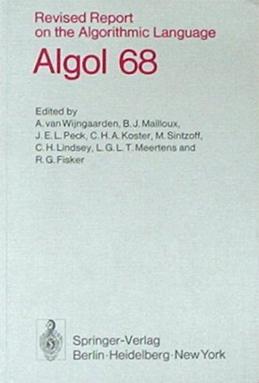Related Research Articles

ALGOL is a family of imperative computer programming languages originally developed in 1958. ALGOL heavily influenced many other languages and was the standard method for algorithm description used by the Association for Computing Machinery (ACM) in textbooks and academic sources for more than thirty years.
In computer science, Backus–Naur form is a notation used to describe the syntax of programming languages or other formal languages. It was developed by John Backus and Peter Naur. BNF can be described as a metasyntax notation for context-free grammars. Backus–Naur form is applied wherever exact descriptions of languages are needed, such as in official language specifications, in manuals, and in textbooks on programming language theory. BNF can be used to describe document formats, instruction sets, and communication protocols.
ALGOL W is a programming language. It is based on a proposal for ALGOL X by Niklaus Wirth and Tony Hoare as a successor to ALGOL 60. ALGOL W is a relatively simple upgrade of the original ALGOL 60, adding string, bitstring, complex number and reference to record data types and call-by-result passing of parameters, introducing the while statement, replacing switch with the case statement, and generally tightening up the language.
In computer programming, a block or code block or block of code is a lexical structure of source code which is grouped together. Blocks consist of one or more declarations and statements. A programming language that permits the creation of blocks, including blocks nested within other blocks, is called a block-structured programming language. Blocks are fundamental to structured programming, where control structures are formed from blocks.

Peter John Landin was a British computer scientist. He was one of the first to realise that the lambda calculus could be used to model a programming language, an insight that is essential to the development of both functional programming and denotational semantics.
ALGOL 60 is a member of the ALGOL family of computer programming languages. It followed on from ALGOL 58 which had introduced code blocks and the begin and end pairs for delimiting them, representing a key advance in the rise of structured programming. ALGOL 60 was one of the first languages implementing function definitions. ALGOL 60 function definitions could be nested within one another, with lexical scope. It gave rise to many other languages, including CPL, PL/I, Simula, BCPL, B, Pascal, and C. Practically every computer of the era had a systems programming language based on ALGOL 60 concepts.

ALGOL 68 is an imperative programming language that was conceived as a successor to the ALGOL 60 programming language, designed with the goal of a much wider scope of application and more rigorously defined syntax and semantics.
In computer programming, a statement is a syntactic unit of an imperative programming language that expresses some action to be carried out. A program written in such a language is formed by a sequence of one or more statements. A statement may have internal components.

Adriaan "Aad" van Wijngaarden was a Dutch mathematician and computer scientist. Trained as a mechanical engineer, Van Wijngaarden emphasized and promoted the mathematical aspects of computing, first in numerical analysis, then in programming languages and finally in design principles of such languages.
ALGOL X was the code name given to a programming language which was being developed as a successor to ALGOL 60, by the International Federation for Information Processing (IFIP) IFIP Working Group 2.1 on Algorithmic Languages and Calculi, which supports and maintains the languages ALGOL 60 and ALGOL 68. It attempted to find a "short-term solution to existing difficulties". ALGOL N and ALGOL W were two other ALGOL versions proposed to fulfill this need.
In computer science, a Van Wijngaarden grammar is a formalism for defining formal languages. The name derives from the formalism invented by Adriaan van Wijngaarden for the purpose of defining the ALGOL 68 programming language. The resulting specification remains its most notable application.
John Edward Lancelot Peck was the first permanent Head of Department of Computer Science at the University of British Columbia (UBC). He remained the Head of Department from 1969 to 1977.
Barry James Mailloux obtained his Master of Science (M.Sc.) in numerical analysis in 1963. From 1966, he studied at Amsterdam's Mathematisch Centrum under Adriaan van Wijngaarden, earning a Doctor of Philosophy (Ph.D.) in 1968.

Cornelis Hermanus Antonius "Kees" Koster was a Dutch computer scientist who was a professor in the Department of Informatics at the Radboud University Nijmegen in the Netherlands.
FLACC is an implementation of the ALGOL 68 programming language.
ALGOL 68-R was the first implementation of the Algorithmic Language ALGOL 68.
Charles Hodgson Lindsey was a British computer scientist, most known for his involvement with the programming language ALGOL 68.
Klaus Samelson was a German mathematician, physicist, and computer pioneer in the area of programming language translation and push-pop stack algorithms for sequential formula translation on computers.
IFIP Working Group 2.1 on Algorithmic Languages and Calculi is a working group of the International Federation for Information Processing (IFIP).
Joseph Henry Wegstein was an American computer scientist.
References
- http://archive.computerhistory.org/resources/text/algol/ACM_Algol_bulletin/1061688/p8-de_morgan.pdf
- ALGOL X and ALGOL Y - Lambert Meertens - CWI Lectures in honour of Adriaan van Wijngaarden - November 2016